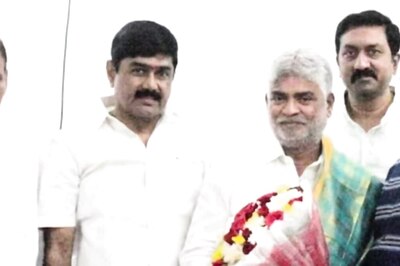
views
A phenomenon of competing narratives that started some three decades ago in the mid-1980s, still defines the politics in India’s most populous and politically crucial state Uttar Pradesh.
Governments have come and gone, but it’s the Hindutva versus caste identity politics that continues to define the core of politics and electoral outcomes. This is still the case despite the ruling BJP’s poll pitch of development and “double engine growth”.
Referred to more commonly as Kamandal vs Mandal narrative, the two have been on opposite ends of the political spectrum, but over the past decade, the BJP seems to have learned the trick to synthesise the two. It is this synthesis that has largely been behind its near total dominance in electoral contests in the state since the 2014 general elections.
The question now is — can the BJP still hold Kamandal and Mandal in good harmony in the Uttar Pradesh elections 2022, or is there a crack in this consolidation? And if there are indeed some cracks, can they be so deep as to challenge the saffron dominance that has been in existence for roughly a decade now?
Peek at the Past
During the hey days of the Ram Temple movement in mid-80s and early-90s, as the BJP and the RSS struggled to expand their political and ideological footprint in the Hindi heartland of Uttar Pradesh, the challenge had come in from rising caste politics.
It was also the period of new-found Dalit assertion in the form of the late Kanshiram and his Bahujan Samaj Party (BSP). Parallel to it was also the new wave of Backward Caste assertion that aggressively came to fore front with the VP Singh government announcing to implement the Mandal Commission recommendations in 1990.
While Kanshiram’s BSP was seen as a natural propeller of rising Dalit consciousness and their desire for larger participation in political power, Mandal politics was also seen as a move to scuttle the expanding Hindutva narrative. After all, the Mandal Commission’s recommendations for 27% reservation to Backward Castes in educational institutions and government jobs had been lying with the central government since 1980.
The pro-Mandal and anti-Mandal sentiments that emerged thereupon saw the emergence of a new politics in states like Uttar Pradesh and Bihar. Leaders like Mulayam Singh Yadav in UP and Lalu Prasad Yadav in Bihar became the new poster boys of Indian politics.
Caught in a fix were the BJP and Sangh Parivar. Despite a spectacular political and social mobilisation for the Ram Mandir movement, the saffron camp was left struggling to cope with the new politics. The desired ‘Hindu Samaj’ was now deeply fractured along caste lines.
As Backward Castes looked the other way, the BJP failed to return to power in Uttar Pradesh in the Assembly elections held in the aftermath of the demolition of the Babri Mosque in Ayodhya in December 1992.
Dalits, on the other hand, had never been close to the RSS ideology. Never been with Jan Sangh, they had also not warmed up to the BJP. For them, the new glue was the BSP, the party which called itself a “movement”. At loss was the Congress, for which Dalit, Brahmins and Muslims had been a support base for decades since Independence.
MANDAL ERA TO MODI ERA
The politics that came in with the Mandal era was largely the same till 2013, in what can be marked as the beginning of the Narendra Modi era. As the then Gujrat CM became the BJP’s pick for prime minister ahead of 2014 general elections, politics in Uttar Pradesh was also at the threshold of being redefined.
Modi not only brought the promise of “acche din” for unemployment- and corruption-weary masses, but in Uttar Pradesh, where OBCs constitute around 50% of the population, he was also a much-needed Backward face. No surprise, the race for 2014 elections saw Modi mention his caste from the stage.
Modi’s personal charisma, along with the organisational restructuring that followed in UP BJP, saw an increasing outreach to non-upper castes, specially the non-Yadav OBCs and non-Jatav Dalits.
An attempt was made to consolidate castes that were not seen as being strongly behind any of the opponents. So if Yadavs among the OBCs were seen firmly with the SP, the BJP focused on non-Yadav OBCs. Similarly, great effort was put to woo non-Jatav Dalits, since the Jatav’s were firmly with the BSP.
The choice of Keshav Prasad Maurya, a non-Yadav OBC face, as the party state president before the 2017 assembly polls was proof of this effort. Maurya had just won the Phulpur Lok Sabha seat on BJP ticket in 2014. The fact that he was brought in by replacing a Brahmin, Lakshmikant Vajpayee, was proof of the BJP’s pragmatism in adjusting with the Mandal dynamics.
The BJP’s new adjustments to caste realities, under the leadership of Prime Minister Narendra Modi and then national president Amit Shah, bore results in 2017. The BJP bounced back to power in the state, winning 322 seats along with the allies, comprising basically of Backward Caste-based parties like the Apna Dal and Om Prakash Rajbhar-led Bhartiya Samaj Party.
CHOICE OF YOGI AS CM
The very first BJP government in UP, the one that was also the majority government, was formed in 1991 and was headed by Hindutva icon and Lodhi OBC face, Kalyan Singh. The RSS had then paved the way for him by describing him as the “natural leader”. Clearly, the Sangh had tried to counter the rising Mandal sentiments with its own projection of the Backward leadership.
Twenty-five years later, as the BJP again came to power with absolute majority, a big surprise came in when the firebrand upper caste Kshatriya, Yogi Adityanath, was picked CM. The choice had not gone unopposed since Maurya’s ambition to be the CM was no secret.
Five years thereon, as the BJP again gears up to fight elections with Modi and Yogi as leadership faces, caste fault-lines aren’t without significance.
There is no denying the fact that the so-called discontent of the non-Yadav OBCs, generally referred to as the MBCs, had been a continuous talking-point all throughout the Yogi rule.
For the moment, the BJP feels confident that with the big brand image of Modi, the Hindutva image of Yogi coupled with the “double engine sarkar” growth narrative, will continue to overcome the caste divisions. The caste rumblings will be withheld by the existing faith in Brand Modi and any concerns about an upper caste as CM will be shadowed by strong Hindu narrative of Brand Yogi.
But these calculations are easier said than done. The Opposition takes hope in the fact that some big ticket OBC movement has been seen against the BJP. Jat-based RLD in the west is now firmly with the Samajwadi Party, and so is former BJP ally Om Prakash Rajbhar in the east. Once the pillar of strength for the BSP, Backward stalwarts Ram Achal Rajbhar and Lalji Verma, too, are now peddling the cycle.
Boosted by the new support and eager to play on caste realities, SP chief Akhilesh Yadav has been trying hard to break through his party’s stereotypical image of MY (Muslim-Yadav) base. The alliances with smaller parties reflect his urge to expand the caste base.
A lot about the Kamandal vs Mandal phenomenon will also be defined by how BSP and Congress do in polls. Akhilesh Yadav feels that a resurgent Congress can impact the BJP’s vote bank by attracting a section of upper caste and urban voters. For the BSP, the challenge will be to retain its hold on the Jatav Dalit vote bank. A division which can be the BJP’s gains.
Past results have shown that a party that grabs roughly around 30% of the votes polled can be in power. In 2007 and 2012, Mayawati and Akhilesh Yadav had formed the majority governments, respectively, with roughly 30% vote share.
In 2017, riding perfectly on the Mandal—Kamandal synthesis, the BJP had swept the polls with around 40% vote share. It will be interesting to see if the BJP can maintain the momentum.
Read all the Latest Politics News here


















Comments
0 comment